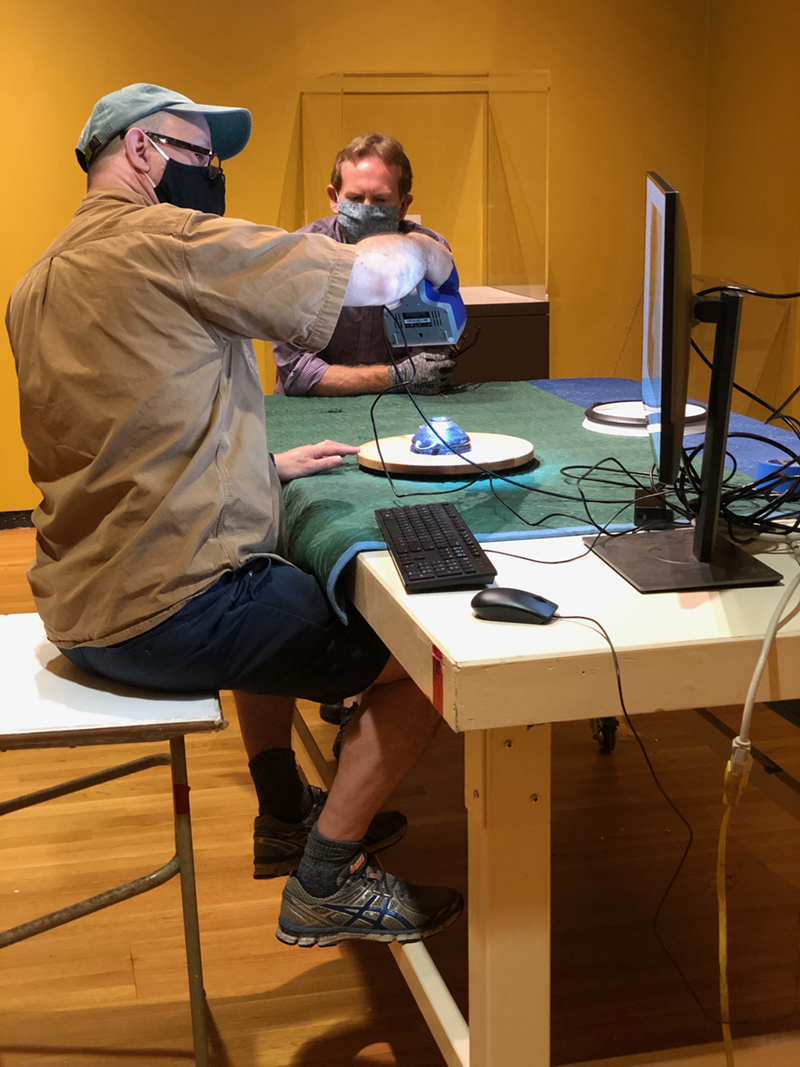3D Scanners Expand Digital Study of Collection at Museum of Art
By Bowdoin College Museum of Art
We are excited to announce that the BCMA has added a major new technology to our digital labs this summer, a pair of 3D scanners from Artec3D. The addition of 3D scanning technologies expands the museum’s capacity to engage faculty and students in innovative teaching and research using the BCMA collection, joining other technologies and expertise added to the BCMA in recent years, including RTI imaging and photogrammetry. These approaches contribute to the Museum’s growing capacity to facilitate innovative object-based learning and technical art history. The BCMA is committed to operating as an innovative lab for faculty and student research by providing not only world-class collections, but also innovative resources, technologies, and tools so that our collections can serve as a platform for creative and original research across the disciplines.
Three-dimensional modeling represents an exciting new frontier in digital approaches to museum collections, and Artec3D scanners are in use at major cultural institutions across the world, including the Smithsonian, The Metropolitan Museum of Art, Harvard, the Louvre, the British Museum, and the V&A. The 3D models they produce have been used by scholars, conservators, and educators in order to study the manufacture of historic objects, to share collections with the public online, to create new educational opportunities, and to repair, restore and recreate objects via 3D printing. Across the world, 3D models are rapidly becoming integral to documentation and preservation of cultural heritage across the world, and have been involved in repatriation resolutions under NAGPRA, pairing up fragments of sculpture in different museum collections, and joining ceramics fragments and virtually restoring artifacts. At Bowdoin, 3D scanning technologies present new opportunities for object-based experiential learning through both established methods of artifact research and the application of emerging digital technologies.
The BCMA has acquired a pair of Artec3D scanners, the Leo and the Space Spider, which represent the most current technology on offer. With help from colleagues in Bowdoin’s Academic Technology and Consulting (ATAC) we are excited to pilot the technology this fall in order to create models from the collection in response to the new demands of remote learning. David Israel (ATAC) explains: “We hope to use the 3D scanning technology to share objects and artifacts with students who would otherwise be engaging with the collection in person at the museum. While it is not a perfect substitute, it is a very promising tool for making these teaching object accessible to students and, in the future, to scholars, students, and others around the world. The details, textures, and dimensionality that we will be able to show are really remarkable. It is a very exciting step forward in the documentation of the collection as well.” As Israel notes, 3D modeling offers a compelling surrogate for the traditional museum experience. Incorporated in remote class visits, course projects, and virtual exhibitions created by Bowdoin classes, 3D models are transformative, providing unfettered virtual access to BCMA collections and allowing faculty and students to go beyond what is capable with traditional reproduction and closely examine objects from the museum’s collections remotely.
The museum has already piloted the use of 3D modeling for curricular purposes, working with Lauren Kohut and students to create models. Lauren Kohut’s course “Descendants of the Sun: The Inca and Their Ancestors” (ANTH 2830 / LAS 2730), used digital imaging to create 3D models of Peruvian vessels in the collections of the Bowdoin College Museum of Art, as well as several in the Bates College Museum of Art collections brought to Bowdoin through a generous class loan. In the process of creating their 3D models, students gained fascinating new insights into their vessels, and into the cultures that created them. Among them, student Niki Bothwick ’20 discovered that a Chimu vessel in the Bowdoin collection had a concealed hole and was a type of whistling vessel that originally made noise when filled with liquids. More information about this exciting class can be found on the Bowdoin news at https://www.bowdoin.edu/news/2019/05/making-khipus-and-pots.html
The BCMA scanners will serve as a shared resource across the campus, one that various departments (including Environmental Studies, Anthropology, and Archaeology) and campus-partners (Arctic Museum and Special Collections) may use with exciting and innovative results. Our diverse collection will benefit from the application of 3D scanning technology for years to come and we imagine exciting new use scenarios coming from our colleagues across campus. Across the disciplines, faculty at Bowdoin are poised to take advantage of the addition of 3D scanning technology to the museum’s capacity for technical art history and object analysis. Many faculty members will incorporate 3D models created by the Artec equipment in their classes, online and in person, including through the Museum’s new ePacket course delivery system. Beyond engaging existing models, many faculty will make use of the scanners in the classroom in order to train their students in the latest approaches and methodologies and to facilitate new understandings of objects in the BCMA collection. Jim Higginbotham writes: “Museum visits that permit students close study of objects are a regular part of all Archaeology courses. With access to the Museum uncertain over the coming year, 3D imaged works can help provide the close study of art from a remote location.”
Sean P. Burrus
Andrew W. Mellon Post-Doctoral Curatorial Fellow
Bowdoin College Museum of Art